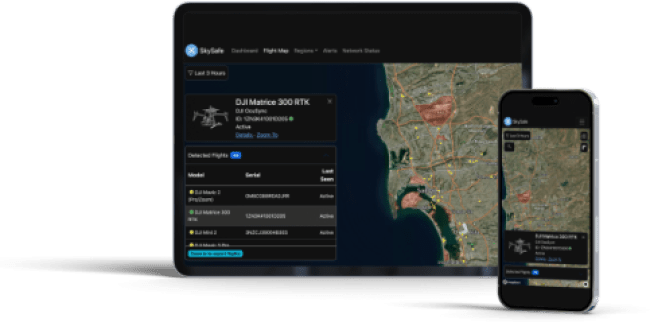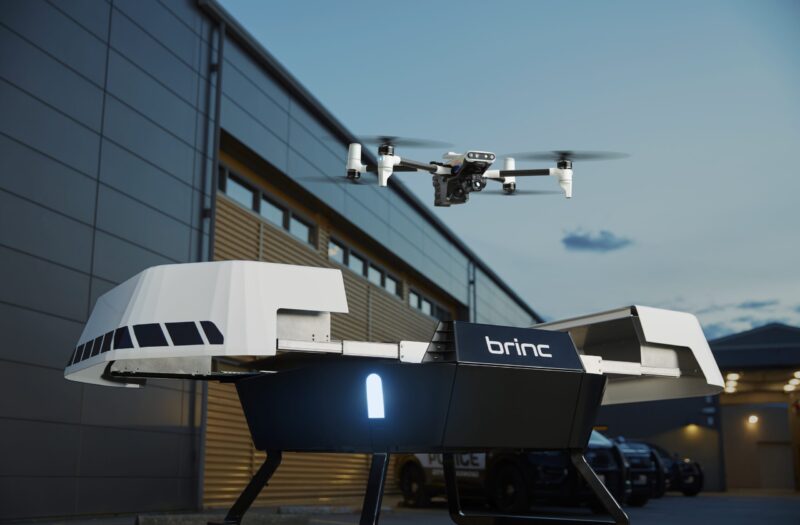Drones on Call: Motorola Integrates UAVs into 911 Systems
Motorola Solutions teams with 2 UAV companies on Drone as First Responder (DFR) Applications
By DRONELIFE Features Editor Jim Magill
A police officer, encountering an emergency situation, pushes a button on his hand-held radio and automatically dispatches a drone to come to his aid. In another scenario a team of officers en route to the site of a potential crime in progress get an advanced video view of what’s happening at the scene before they arrive, thanks to a drone dispatched as soon as the 911 call comes in.
These are just two of the ways in which security technology company Motorola Solutions is advancing the development of drones as first responder (DFR) programs, through its newly formed partnerships with two UAV companies.
In April, Motorola Solutions announced it was investing in BRINC, a producer of security drones and systems, and SkySafe, a developer of UAV airspace management systems. In addition, Motorola said it would form strategic alliances with the two drone-related companies in order to integrate DFR and drone-detection technologies into its 911 command center product, CommandCentral.
“These partnerships really set us up as the market leader in the public safety workflow software, Jeremiah Nelson, Motorola Solutions corporate vice president, said in an interview. “We’re working with SkySafe and BRINC, to be able to not just provide that technology, but provide it in a way that agencies can really drive the best outcomes for their communities.”
Currently, more than 60% of North America’s emergency and public safety agencies rely on Motorola Solutions’ 911 command center software, the company said in a statement. “The BRINC and SkySafe partnerships are bringing DFR capability into that response, as well as the situational awareness of drone traffic and being able to use that within the public safety workflow,” Nelson said.
Integrating drone data with 911 dispatch systems
Under its agreement with SkySafe, Motorola Solutions is able to incorporate drone-based video and data into its 911 dispatch systems, he said.
“From the DFR standpoint, it’s really about getting situational awareness, live videos in particular, as fast as possible so that officers know what they’re walking into,” Nelson said. “As soon as the 911 call comes in, that can get passed over through the software to the drone team and the drone pilot can get up and fly out, get eyes on the scene and stream that video back.”
As a result of one of its partnerships, Motorola can offer its public service agency customers access to SkySafe’s UAV airspace-management technology.
“Drone usage is increasing and will only continue to increase,” Nelson said. SkySafe’s technology will give the agencies the ability to identify and track the routes of drones operating in their communities, providing crucial information for law enforcement personnel working to secure the airspace, especially around sites of major concern, such as sports arenas or power plants, he said.
“SkySafe gives an ability to understand where and what the drone traffic is in a community. Is it expected? Is it illicit? If it’s illicit, where is it taking off from? And then law enforcement can use that to actually go and derive a response,” he said.
“We are thrilled to be doing a partnership with Motorola Solutions,” Melissa Swisher, chief revenue officer of SkySafe said. “Because if you think about it, SkySafe is laser-focused on drone detection and airspace security, while Motorola Solutions has built that gold-standard platform for public safety, communications, and command and control.”
She said SkySafe recently completed the integration of its airspace security technology with Motorola’s CommandCentral Aware platform, which allows customers to view data sets from divergent sources on a single screen.
“The law enforcement officers don’t have to swivel between multiple systems and guess what’s in the air,” Swisher said. “They get that single operating picture of that situational awareness and improve their response times through that integration.”
The integrated system will allow law enforcement agencies to receive an alert when an unauthorized drone enters a restricted airspace, such as over a crowd at an outdoor festival.
“Then that law enforcement agent would be able to see details such as the flight path, the altitude and even identify the make and model of that drone,” she said. That data is instantly correlated with the rest of Motorola’s situational-awareness tools such as video feeds from body-worn cameras, to help the security personnel to immediately react to any potential threat from a UAV.
“Instead of that officer and that team having to piece those things together after the fact, officers on the ground can actually then be directed in real time to locate that operator and address that threat immediately, quickly and safely,” Swisher said.
BRINC offers drones built for DFR
Nelson said Motorola helped pioneer the DFR revolution with the introduction of its CAPE video and flight control package, which could be uploaded onto multiple brands of drones. Now, through its partnership with BRINC, the company is preparing to step up into the next phase of DFR evolution by deploying drones specifically designed and built for DFR programs.
“BRINC is a purpose-built manufacturer of drones for DFR. They have built a drone that is made for law enforcement, with lights and sirens very clearly marking a law enforcement drone designed for first responder operation,” he said.
In addition, BRINC’s DFR drones are designed to carry a payload of emergency supplies, such as doses of the drug-overdose treatment Narcan or an EpiPen, which can be delivered to persons on the ground dealing with an emergency medical situation.
“We’re very excited to be working with Motorola. They’re the world’s largest public safety technology company. I think our products are extremely complementary,” said BRINC’s founder and CEO Blake Resnick. He said Motorola Solutions participated in BRINC’s recent $75 million fundraising round and the two companies are working together closely to develop a “go-to-market” strategy for their combined package of products.
One notable example of such product synergy is the integration of Motorola’s portable police radios with BRINC’s 911 drone dispatch system.
“Motorola is of course the market leader in body-worn radio systems. If an officer or a firefighter ever pushes the emergency button on one of those radios, it will be able to trigger one of our drones to take off from one of our recharging pods on a police or fire station roof, effectively launching and then flying right to the location of that radio,” Resnick said.
In addition, BRINC is working to integrate its drone-dispatch systems with Motorola’s computer-aided dispatch (CAD) systems. “When someone calls 911, we would grab the GPS coordinate of that call from CAD,” he said. “We’re integrating with both Premier One and Flex, which are their CAD offerings. And again, that could trigger a drone flight.”
The two companies are also working to combine Motorola’s ground-based license-plate reader cameras with BRINC’s drone-based software systems, which would allow a drone to locate and give chase to a suspect vehicle, without endangering officers by forcing them to engage in a high-speed chase.
Nelson predicted that the market for the combined technology solutions created by the partnerships with BRINC and SkySafe would continue to grow, fueled both by the growing number of agencies undertaking DFR programs “and just the increasing prevalence of drones and agencies needing to understand what’s happening in the skies,” he said.


